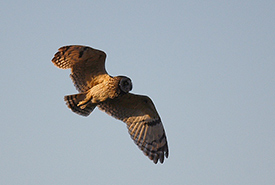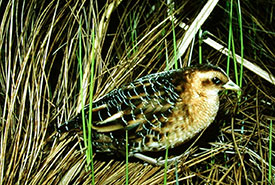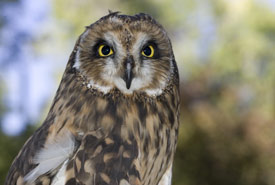Nocturnal or diurnal bird?
The yellow rail and short-eared owl - Two threatened species on Isle-aux-Grues
Short-eared Owl (Photo by Etienne Artigau)
Known for its famous cheese factory and for its celebrated resident, the late Quebec painter and sculptor Jean-Paul Riopelle, Île aux Grues is also an important site for the conservation of a number of bird species. Located in the Saint Lawrence estuary downstream from Quebec City, it is the preferred refuge of several migratory birds.
Yellow rail

Yellow rail (Photo by J. Brisson)
The yellow rail is a small nocturnal bird. It is not well known, particularly due to its discrete and furtive behaviour as well as the type of habitat it prefers. Rather than flying away when a human approaches, it stays put, remaining well hidden in the vegetation with its perfectly adapted camouflage. When nesting, the female looks for a marsh with a carpet of dead vegetation, which she uses to build and hide her nest, weaving a roof out of stems and dried leaves. In order to encourage the yellow rail to nest, it is important to limit mowing and burning during its nesting season, in order to conserve a carpet of dead vegetation on the ground.

Short-eared owl (Photo by Gregory Johnston)
Short-eared owl
The short-eared owl, on the other hand, is active during the day. Its diminutive ears make it well-deserving of its name. Although this owl lives in a variety of open landscapes, such as fens and some agricultural land, it avoids the forest interior. When nesting, it prefers tall grasses. During migration, up to 12 individuals have been found hunting together in the Île aux Grues sector, and some pairs have returned to the site to nest every year.
Habitat conservation
Yellow rail and short-eared owl populations have undergone a serious decline in the last decade throughout their distribution range in North America, primarily as a result of a decrease in their habitats due to increased agriculture, residential development and wetland drainage. In addition, agricultural mechanization and intensive foraging have contributed to increased egg mortality.
The Nature Conservancy of Canada (NCC) protects land on both sides of Île aux Grues. The bog, located between Île aux Grues and Île aux Oies, provides habitat to several ground-nesting species such as the at-risk yellow rail and short-eared owl. NCC’s involvement on Île aux Grues is contributing to the protection of a mosaic of habitats favourable to several species, and benefitting the public. In addition, the protected lands serve as living laboratories, enabling scientists to improve their knowledge of the species living there, and to develop best practices for the protection of these species.




